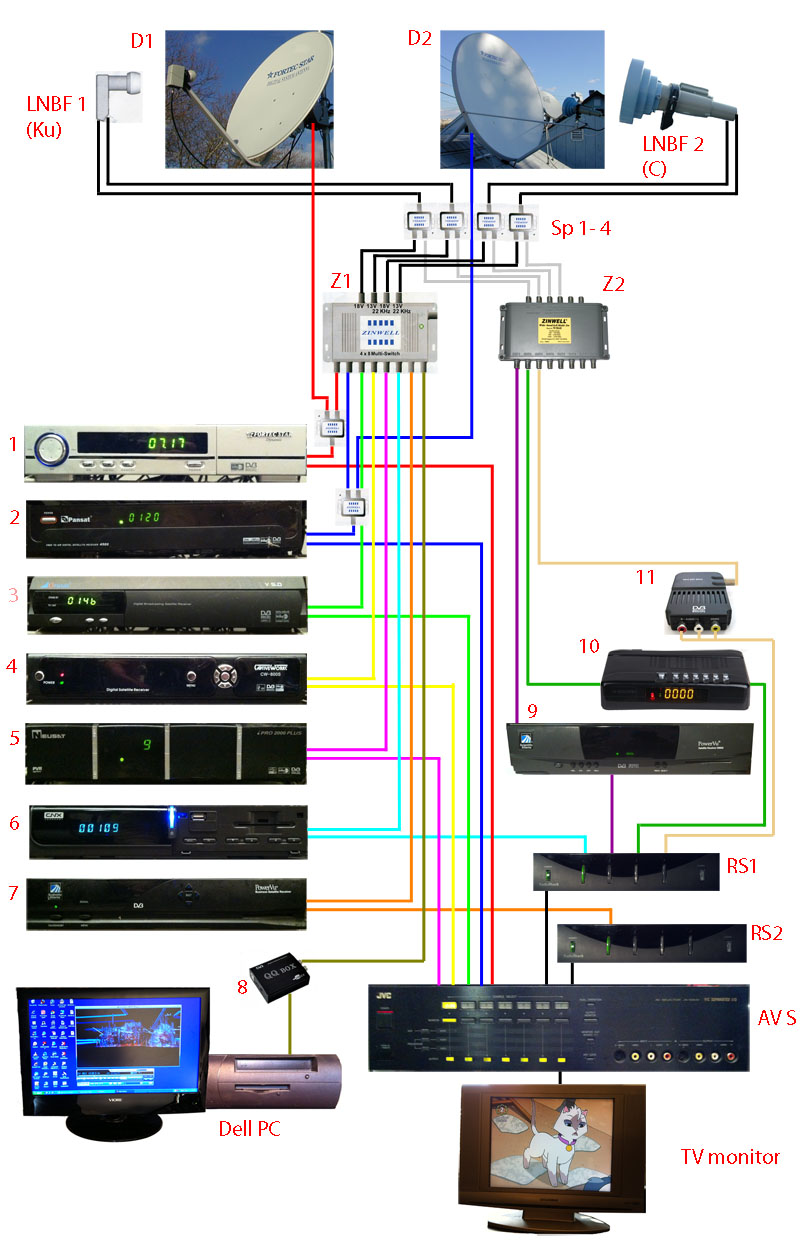In 2008 I became dissatisfied with
my cable TV provider and switched to a commercial
satellite company. I had heard of home satellite
systems for many years and had seen the "Big Ugly
Dishes" (BUDs as they are known) especially in rural
areas. I learned that there is a thriving hobby
of do-it-yourself home satellite dish owners who set
up their own "free-to-air" systems to view whatever is
being beamed to earth from the "birds" flying
miles above the equator.
For Christmas 2008, I was given a Sadoun M1 FTA
Motorized Satellite System (Ku) that included the
Fortec Star FC 80 dish and Fortec Star Dynamic
receiver (see below). After many hours of setting up
and "peaking" the equipment in the frigid Pennsylvania
winter, I was so happy with the result that two months
later I ordered a similar 1.2 meter dish package for
C-band transponders. The latter included a GeoSat CK-1
LNBF for both C- and Ku-band reception and a Sadoun
SDS41C four-way DiSEq switch enabling the Fortec Star
receiver to access both dishes. A
log of channels found
was started in 2009 but since transponders and even
satellites come and go, it has not been maintained. A
Pansat receiver was added to control the C-band dish
independently from the Fortec Ku system and a Radio
Shack A/V switch was used to share one monitor. A
BSC621-2 C/Ku LNBF soon replaced the GeoSat allowing
access to both the C and Ku bands through a single
cable. Thanks to eBay the system grew rapidly and as
more receivers were added a more robust JVC A/V
selector replaced the Radio Shack, and a Zinwell
multi-switch replaced the SDS41C. Along the way the
BSC621-2 C/Ku was replaced by a WS International DMX
242 dual C LNBF allowing any receiver to access C-band
channels simultaneously in both horizontal and
vertical polarities. Still more receivers
required a second Zinwell switch in tandem with the
first and two Radio Shack A/V selectors to supplement
the JVC. By 2015 the installation comprised eleven
receivers connected to two satellite dishes as shown
in the diagram below with room to continue expansion
through the remaining Zinwell ports.
The components (2015) were as follows:
D1:
|
Fortec Star FC 80 CM (Ku band)
satellite dish with DiSEqC 1.2 HH motor
|
LNBF 1:
|
Sadoun Kul 1 LNBF |
D2:
|
Fortec Star FC 120 CM (C band)
with DG-380 motor |
LNBF 2:
|
WS International DMX 242 LNBF |
Sp 1 - 4:
|
Four signal splitters
|
Z1, Z2:
|
2 Zinwell 4 x 8 multi-switches
|
1:
|
Fortec Star Dynamic |
2:
|
Pansat 4500 (2009) |
3:
|
Orasat V5.0 |
4:
|
Captive Works CW 800S |
5:
|
Neusat I Pro 2000 |
6:
|
CNX Duo |
7:
|
PowerVu D9835 |
8:
|
QQ Box |
9:
|
PowerVu D9234 |
10:
|
X2-M1 |
11:
|
Mini Sat 2012
|
AV S:
|
JVC JX-S900 A/V selector |
RS1, RS2:
|
2 Radio Shack 15-1977 A/V
selectors
|
All eleven receivers connect to both dishes through
the Zinwell multi-switches and splitters. The Fortec
receiver is connected directly to the Ku band dish
motor (D1) and the Pansat receiver is connected
directly to the C-band dish motor (D2) so that only
those receivers will position their respective dishes.
Any receiver may access either dish independently by
setting the 22khz signal to the Zinwell multi-switches
(on = Ku, off = C). Except for the QQ Box receiver,
which is connected directly to the Dell PC, all
receivers feed to the JVC or Radio Shack A/V selectors
as shown which select the signal going to the TV
monitor. (The Radio Shack selectors are necessary
since the JVC only has seven A/V ports. Of course, the
same viewing options could be accomplished using only
one receiver and one 2-way multi-switch but the
interest is in comparing the features of the different
receivers.
Pansat 3500SD (spare, not shown)



